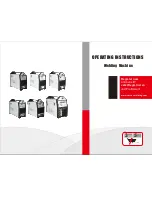
34
USER MANUAL
▪
Red Rooster Lifting Limited
▪
Nauta House, The Meadows, Oldmeldrum, Aberdeenshire, AB51 0EZ
▪
Tel: +44 (0) 1651 872101
▪
M01-AH27 REV2
EXPLOSION PROTECTION
11.1
The UK is now covered by the UK Ex scheme for the use of non-electrical in hazardous areas and is covered by the ‘Product Intended for use in
Potentially Explosive Atmospheres Regulation 2016’ (UK SI 2016: No 1107 as amended by UK SI 2019 No 696 Schedule 25, schedule 3A, Part 6)
For Europe and many other parts of the world we also offer ATEX Non-electrical equipment certified under the ATEX 2014/34/EU Directive.
For both the UK Ex and ATEX this is split into two categories of equipment available from Red Rooster – Group – I mining (I M2 De-energised in
an emergency) and group II – Zone 1 + 21 & Zones 2 + 22)
The Explosive Protection Level (EPL) has been set when the effective ignition sources are identified and when they become effective in normal
operation and in the case of expected malfunctions. The normal ambient temperature range for Red Rooster air hoists is
-20°C to +60°C.
As standard all Red Rooster air hoists are certified as Group II Category 3 (Zone 2 Gas or 22 Dust)
This excludes the TMM-140 & TCR-250 ME. (standard only)
Standard hoists are suitable for use in ZONE 2 Gas areas certified as Ex Group II 3 G Ex h IIB T4 Gc
Standard hoists are suitable for use in ZONE 22 Dust areas certified as Ex Group II 3 D Ex h IIIB T135°C Dc
With extra protection can be used in ZONE 1 Gas areas certified as Ex Group II 2 G Ex h IIB T4 Gb
With extra protection can be used in ZONE 21 Dust areas certified as Ex Group II 2 D Ex h IIIB T135°C Db
Further protection allows the hoist to work in ZONE 1 Gas areas certified as Ex Group II 2 G Ex h IIC T4 Gb
Further protection allows the hoist to work in ZONE 21 Dust areas certified as Ex Group II 2 D Ex h IIIC T135°C Db
(not suitable for TCR Mini or TCS range, IIC or IIIC areas)
Red Rooster hoists will cover temperature classes T1 to T4 so can be certified to work with all Gases with the exception of Carbon Disulphide
which is in temperature class T6.
The glow temperatures for dusts must be above 220°C or ignition temperatures above 202°C for use in Zones 21 and 22.
Mining – Ex Group I M2 Ex h I Mb (Mechanical equipment de-energised in an emergency)
TROLLEYS AND OVERHEAD CRANES
Red Rooster trolleys and overhead cranes use standard steel wheels for use in a Zone 2 + 22 area and normally with Bronze wheels in a
Zone 1 + 21 area with a Gas group of IIB or IIC and Dust group IIIB or IIIC. The normal running speeds of our trolleys and overhead cranes are
less than the 1 m/s that the standard allows. (Steel wheels can be acceptable for Zone 1 Gas Group IIB / Dust Group IIIB)
When built into an assembly such as an overhead crane the UK Ex / ATEX rating will be for the complete assembly, which may be less than some
of the individual parts.
SPECIAL INSTRUCTIONS
This section of the manual refers to special instructions, exclusions or warnings about the equipment.
LUBRICATION
Lubrication oil should not have an ignition temperature below T135°C (T4) BS EN80079-36:2016.
Several gases such as hydrogen sulphide and ethylene oxide are at the very top of the IIB temperature class and are extremely flammable so
you may wish to include them in the higher IIC temperature class. This is also relevant for impact sensitive dusts, around light metals, dusts with
glow temperatures less than 210°C and ignition temperatures below 202°C. In an area where combustible dusts are present the surface
temperature cannot exceed two thirds of the minimum ignition temperature of the dust and air mixture or the glow temperature of the dust.
Ambient temperature range for air hoists and air trolleys is -20°C≤Ta≤+60°C
Some models of Red Rooster equipment can only be certified for use in temperature class T5 or T6 when a special assessment has been
completed.
Air motors, control valves and hoses are all positively pressurised so gas or dust cannot penetrate internal parts when operating or when under
pressure.
Red Rooster hoists and trolleys are constructed to avoid the build-up of dust deposits. But where dust does build up, provision shall be made for
removal of the dust and keeping the hoist, trolley and pipework clean.
External influences such as heat from direct sunlight or exhausts can affect the hoist so the ambient temperature should be checked. Other
influences such as cold, wind, water, compressor air temperature, contact with chemicals and mechanical hazards can all have an affect on the
hoist operation.
















































